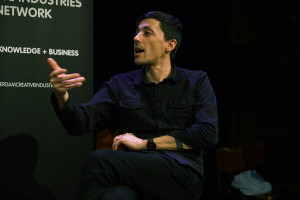By Joana Chicau
Paolo Cirio is an Italian conceptual artist and hacktivist. His work is essentially building on a critical theory of information power and how that impacts the dynamics of social structures among individuals, governments and corporations. He investigates fields related to copyright, privacy, finance democracy and cyber-security, which then take the shape of multimedia installations, performance, or interventions. While combining his research with a hybrid artistic scenery, he sees in art a channel for reliable communication and a new form of perceiving reality: “I’m against faking data, you don’t want to lose the audience’s trust. A layer of artistic scenario is good for getting the audience to engage, but you should provide an informative artwork, and not merely speculative one.”
For the MoneyLab symposium Cirio presented two projects that are part of his work on economic and financial system: The Daily Paywall and The Loophole for All.
Daily Paywall
The first project concerns the value of information and its distribution, bringing its dark side to light. The Daily Paywall is an assemblage of over 60,000 pay-per-view articles from the Financial Times, The Wall Street Journal and The Economist, published during the year of 2014. By accessing the content of the journal through a paid subscription and a scripting language hack, Cirio gathered an enormous database of financial news which were then re-published and made available for free on his own page: dailypaywall.com.
For the sake of financial literacy and general public awareness, the artist then proposed to pay people to read the featured articles and for the reader to answer correctly a set of questions part of a quiz. Simultaneously the online platform also allowed for donations to writers and journalists which were then able to claim compensation for there work.
Whilst leaving the official publishers out of the circle, Cirio presented a new circular and provocative economic business model, that opened access to information on global economic matters: “A very useful tool for investigation and knowledge in economy.” Only the Financial Times along with some of the publishing companies involved didn’t agree with the statement, having sent a legal letter that made the project shut down, after five days of online existence and 1000 copies freely distributed all over New York City.

Loophole 4 all
The second project its an investigation on offshore financial systems. Loophole 4 published a list of 200.000 Cayman Islands companies that practice tax evasion, hide money and debt. The website loophole4all.com not only reveals this information but also promotes the sale of the real identities of anonymous Cayman companies at low cost prices (= 99 cents).
In four easy steps anyone can hijack a company in the Cayman Islands, a corporate provocation that elicited reactions raging from local businesses to multinational companies, as well as Cayman authorities, international law firms and accounting firms such as PayPal. “I made a scheme to avoid legal prosecution; to run this project I set up an account in London, and used PayPal in Luxembourg. All the data has also been transferred to California because of privacy issues.” Since the artist is Italian his personal identity is safe.
“Do you want to change the world?”, someone asked from the audience. “Not really” claimed Paulo Cirio, “but these places have been doing these things for so long, and no one really knows whats going on.”Paulo Cirio’s artworks give us a glimpse of urgent topics under the fields of finance and economics, but most importantly, enable public discourse. His presence at the MoneyLab brought a valuable insight on interventionism in media art, questioning the vulnerability of social, economical, legal and technological structures in contemporary society.


